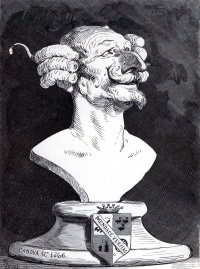First-person narrative
From The Art and Popular Culture Encyclopedia

|
Related e |
|
Featured: |
First-person narrative is a narrative mode where a story is narrated by one character at a time, speaking for and about themselves. First-person narrative may be singular, plural or multiple as well as being an authoritative, reliable or deceptive "voice" and represents point of view in the writing.
The narrators explicitly refer to themselves using words and phrases involving "I" (referred to as the first-person singular) and/or "we" (the first-person plural). This allows the reader or audience to see the point of view (including opinions, thoughts, and feelings) only of the narrator, and no other characters. In some stories, first-person narrators may refer to information they have heard from the other characters, in order to try to deliver a larger point of view. Other stories may switch from one narrator to another, allowing the reader or audience to experience the thoughts and feelings of more than one character.
Contents |
Forms
First-person narratives can appear in several forms: interior monologue, as in Fyodor Dostoevsky's Notes from Underground; dramatic monologue, as in Albert Camus' The Fall; or explicitly, as in Mark Twain's Adventures of Huckleberry Finn.
Point of view device
Since the narrator is within the story, he or she may not have knowledge of all the events. For this reason, first-person narrative is often used for detective fiction, so that the reader and narrator uncover the case together. One traditional approach in this form of fiction is for the main detective's principal assistant, the "Watson", to be the narrator: this derives from the character of Dr Watson in Sir Arthur Conan Doyle's Sherlock Holmes stories.
In the first-person-plural point of view, narrators tell the story using "we". That is, no individual speaker is identified; the narrator is a member of a group that acts as a unit. The first-person-plural point of view occurs rarely but can be used effectively, sometimes as a means to increase the concentration on the character or characters the story is about. Examples: William Faulkner in A Rose for Emily (Faulkner was an avid experimenter in using unusual points of view - see his Spotted Horses, told in third person plural);Frank B. Gilbreth and Ernestine Gilbreth Carey in Cheaper By the Dozen; Frederik Pohl in Man Plus; and more recently, Jeffrey Eugenides in his novel The Virgin Suicides and Joshua Ferris in Then We Came to the End. (Also used to good effect by Theodore Sturgeon in his short story "Crate".)
First-person narrators can also be multiple, as in Ryūnosuke Akutagawa's In a Grove (the source for the movie Rashomon) and Faulkner's novel The Sound and the Fury. Each of these sources provides different accounts of the same event, from the point of view of various first-person narrators.
The first-person narrator may be the principal character or one who closely observes the principal character (see Emily Brontë's Wuthering Heights or F. Scott Fitzgerald's The Great Gatsby, each narrated by a minor character). These can be distinguished as "first person major" or "first person minor" points of view.
Styles
First-person narrative can tend towards a stream of consciousness, as in Marcel Proust's In Search of Lost Time. The whole of the narrative can itself be presented as a false document, such as a diary, in which the narrator makes explicit reference to the fact that he is writing or telling a story. This is the case in Bram Stoker's Dracula. As a story unfolds, narrators may be more or less conscious of themselves as telling a story, and their reasons for telling it, and the audience that they believe they are addressing, also vary wildly. In extreme cases, a frame story presents the narrator as a character in an outside story who begins to tell his own story, as in Mary Shelley's Frankenstein, for example.
First person narrators are often unreliable narrators since a narrator might be impaired (as in The Last Film of Emile Vico by Thomas Gavin, or Benjy in Faulkner's The Sound and the Fury), lie (as in The Quiet American by Graham Greene, or The Book of the New Sun series by Gene Wolfe), or manipulate his or her own memories intentionally or not (as in The Remains of the Day by Kazuo Ishiguro, or in Ken Keasey's One Flew Over the Cuckoo's Nest). Henry James discusses his concerns about "the romantic privilege of the 'first person'" in his preface to The Ambassadors, calling it "the darkest abyss of romance."
One convoluted example of a multi-level narrative structure is Joseph Conrad's novella Heart of Darkness, which has a double framework: an unidentified "I" (first person singular) narrator relates a boating trip during which another character, Marlow, tells in the first person the story that comprises the majority of the work. Even within this nested story, we are told that another character, Kurtz, told Marlow a lengthy story; we are not, however, directly told anything about its content. Thus we have an "I" narrator introducing a storyteller as "he" (Marlow), who talks about himself as "I" and introduces another storyteller as "he" (Kurtz), who in turn presumably told his story from the perspective of "I".
See also

